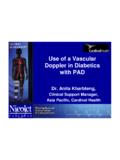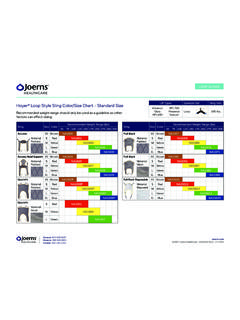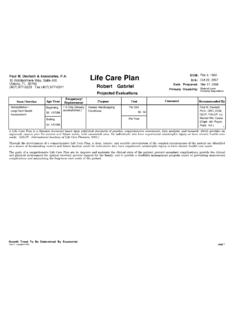Transcription of 2 Graded Motor Imagery GMI is an individually …
1 2 Neuro Orthopaedic Institute | Graded Motor Imagery HandbookG. Lorimer MoseleyDavid S. ButlerTimothy B. BeamesThomas J. GilesReferences1/ Graded Motor Imagery is effective for long-standing complex regional pain syndrome: a randomised controlled trial., Moseley, , Pain 2004 2/ Is successful rehabilitation of complex regional pain syndrome due to sustained attention to the affected limb ? A randomised clinical trial. Moseley, , Pain 2005 3/ Graded Motor Imagery for pathologic pain: A randomized controlled trial.
2 Moseley, , Neurology 2006 4/ Does evidence support physiotherapy management of adult Complex Regional Pain Syndrome Type One? A systematic review. Daly, A. E., Biolocerkowski, A. E., European Journal of Pain, 2008. CONCLUSIONS: Graded Motor Imagery should be used to reduce pain in adult CRPS-1 patients. Further, the results of this review should be used to update the CRPS-1 clinical guidelines. Graded Motor ImageryGMI is an individually tailored treatment process which has successfully been used for persistent and complex pain states 1,2,3,4.
3 It aims to give flexibility and creativity back to the brain via Graded Graded Motor Imagery Handbook, Moseley GL, Butler DS, Beames TB, Giles TJ. Noigroup Publications, Adelaide, Australia, 20122 Neuro Orthopaedic Institute | is normal ? Broad guidelines are: You don t know you are mentally moving Premotor cells modify primary Motor cells without activating them Less likely to activate the pain neurotagImplicit Motor Imagery (left/right judgements)ReferencesParsons LM., Integrating cognitive psychology, neurology and neuroimaging.
4 Acta Psychologica 2001;107 J, Coslett HB, Bradt J, et al. Pain and the body schema: effects of pain severity on mental representations of movement. Neurology 2002;59 S, Butler DS, Darmawan I, et al., Motor Imagery of the neck. Age, gender, handedness and image rotation affect performance on a left/right neck rotation judgement task. Submitted J, Butler DS, Fulton I, et al., Implicit Motor Imagery in people with a history of back pain, current back pain, both or neither. Submitted 2012. Aim for accuracy of 80% and above Similar results for left and right (no bias) Aim for response time (speed) of seconds +/- seconds for necks and backs Aim for response time (speed)
5 Of 2 seconds +/- seconds for hands and feet Consistent over a period of at least a weekB - Acute left hand injury looking at left handResponse timeResponse timeAccuracyAccuracyLLLLRRRRW rong choice, start againWrong choice, start againXXAcute LEFT hand injury looking at RIGHT handAcute LEFT hand injury looking at LEFT handChronic LEFT hand injury looking at RIGHT handChronic LEFT hand injury looking at LEFT handAcuteChronicA - Acute left hand injury looking at right handC - Chronic left hand injury looking at right handD - Chronic left hand injury looking at left handABCDD ifficult decision.
6 Safest to presume it s LEFT hand because my LEFT hand is injured choose LEFT handMentally move LEFT handMentally move RIGHT handCorrect!Correct!Mentally move LEFT handDifficult decision, Safest to presume it s LEFT hand because my LEFT hand is injured choose LEFT handDifficult decision, Safest to presume it s RIGHT hand because my LEFT hand is in trouble and I m protecting it by not focusing on itMentally move RIGHT handCorrect!Difficult decision, Safest to presume it s RIGHT hand because my LEFT hand is in trouble and I m protecting it by not focusing on itCorrect!
7 Mentally move LEFT handMentally move RIGHT hand2 Neuro Orthopaedic Institute | Where do I practice explicit Motor Imagery ? At home, work, school, on the bus, in the bath? Do I keep my eyes open or closed during Motor Imagery ? What position do I adopt during Imagery ? Sitting, standing, lying? Do I think of myself moving (first person) or someone else moving (third person)? How long should I perform Imagery for and how many times a day? What is the task complexity and intensity and how does it tie in with grading my exposure?
8 What words should the therapist use to describe or talk through the process? What words should the user think of when going through the process? What cues can be used to heighten the process? Sounds, memories, smells? Should there be prior demonstration of the movement by another person (therapist, family member)? Do I use relaxation or meditation in conjunction? How much do I know about the changes in the brain that I can achieve with Imagery ?Thinking about moving without actually moving imagined are many different ways to go through the process and the most common method used in GMI is a first person perspective of feeling your own movement and postures.
9 Graded activation of the brain through observation, imagining movements and actual Motor ImageryReferencesEhrson HH., et al,. Imagery of voluntary movement of fingers, toes, and tongue activates corresponding body-part-specific Motor representations. J Neurophysiol. 2003 Nov;90(5) board Observing movementImagining movementPerforming movement2 Neuro Orthopaedic Institute | a mirror boxIn this situation the problematic limb is hidden in the box. Looking at the mirror image of the left limb gives the illusion of seeing the hidden right as illusionistMirror therapy means looking into a mirror to see the reflection of the limb or body part in front of it.
10 The mirror will effectively give the illusion that you are looking at the limb that is hidden. Brain activation during mirror therapy is less than actual movement but slightly more compared with imagining the same movement. Mirror Therapy (1)ReferencesDiers M., et al. Mirrored, imagined and executed movements differentially activate sensorimotor cortex in amputees with and without phantom limb pain. Pain 20102 Neuro Orthopaedic Institute | and examples of progression for using a mirror boxMirror Therapy (2)







